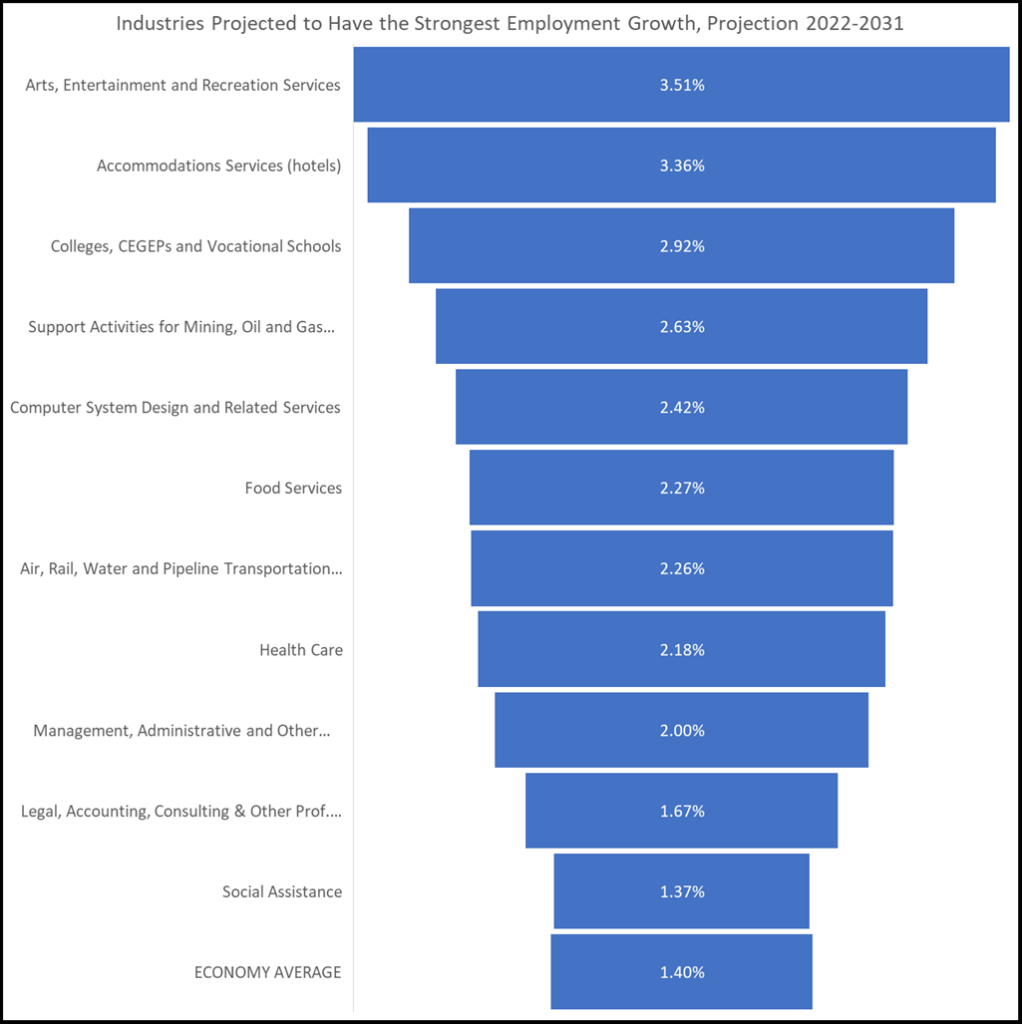Chapter 2: The Job Market
2.3 Projecting Job Growth in Canada
The Canadian government uses the NOC codes and industry statistical information to project job growth in a system called the Canadian Occupational Projection System. The Canadian Occupational Projection System (COPS) combines assessment of recent labour market conditions and projections of labour supply and demand to project future job shortages or surpluses.
In the projections for a period from 2024-2033, COPS used 485 of the 516 NOC occupations. Data was deemed unreliable for 31 occupations due to small employment numbers. COPS projects that over the next ten years, 2.6 million new jobs will be created, which is on average 259,000 jobs per year.
Projected Employment Growth 2024 - 2033
| COPS Code & Name | Employment (2023) | Employment Growth (2024 - 33) |
Future Labour Market Conditions (2024 - 33) |
|---|---|---|---|
| 31204 Kinesiologists and other professional occupations in therapy and assessment |
9,400 | 430 | Balance |
| 32109 Other technical occupations in therapy and assessment |
20,600 | 1,130 | Shortage |
| 33109 Other assisting occupations in support of health services |
32,000 | 1,860 | Balance |
| 41406 Recreation, sports and fitness policy researchers, consultants and program officers |
9.300 | 330 | Balance |
| 50012 Recreation, sports and fitness program and service directors |
5.800 | 260 | Balance |
| 54100 Program leaders and instructors in recreation, sport and fitness |
149,300 | 4,530 | Balance |
| 64322 Outdoor sport and recreational guides |
1,700 | ||
| 65211 Operators and attendants in amusement, recreation and sport |
65,200 | 21,600 | Balance |
| 70012 Facility operation and maintenance managers |
35,300 | 1,650 | Balance |
| Total | 328,600 | 31,790 |
Definitions:
| Balance | means a balance between job openings and job seekers |
| Shortage | means more job openings than job seekers |
| Employment | persons 15 years and over who had a job |
| Employment Growth | annual change of employment (projected for 2024 - 2033) |
Source: COPS Occupational Projections Summaries (2024-2033)
Statistics Canada also uses the COPS data to examine and predict job growth by industry as industry is used to examine global trade. In Canada, we use the North American Industry Classification System. This is a standardized classification for the US, Canada and Mexico (NAICS 2022 version 1.0) originally created for the North American Free Trade Agreement. For more information on NAICS, visit their website.
The NAICS consists of 20 sectors, which represent 695 industries. The industries are identified by their principal activity, defined as their main profitable endeavour. For a list of the 20 sectors with their definitions, go to NAICS - Canada 2022
Of interest to the Recreation and Leisure Industry is Code 71: Arts, entertainment, and recreation:
"This sector comprises establishments primarily engaged in operating facilities or providing services to meet the cultural, entertainment and recreational interests of their patrons. These establishments produce, promote or participate in live performances, events or exhibits intended for public viewing; provide the artistic, creative and technical skills necessary for the production of artistic products and live performances; preserve and exhibit objects and sites of historical, cultural or educational interest; and operate facilities or provide services that enable patrons to participate in sports or recreational activities or pursue amusement, hobbies and leisure-time interests. There are establishments engaged in activities related to arts and recreation that are classified in other sectors of NAICS” (Statistics Canada, 2022).
As you can see by the above description, even NAICS notes that jobs in Recreation and Leisure cross multiple industries.
Employment Growth Projections
Source: ESDC 2022 COPS industrial projections.
Recreation and Leisure Industry jobs can be found across 3 of the above industries: Arts, Entertainment and Recreation, Health Care, and Social Assistance. This means that there are currently jobs available for graduates of Recreation and Leisure Services programs, and as there is predicted job growth across nearly all areas of the industry, there will be a demand for graduates in the future.
This chart shows that the highest expected job growth is predicted in jobs that entail interpersonal tasks (jobs in the Recreation and Leisure Industry fall under interpersonal tasks).
Source: ESDC 2024 COPS Projections.
Routine = repeating of same manual or cognitive tasks
Non-Routine = cognitive analytical and interpretation tasks, thinking creatively or requiring
physical skills and adaptability
Interpersonal = establishing and maintaining relationships, guiding, coaching, directing, and motivating others
For more in-depth and up-to-date information on the labour market trends in Ontario, go to Job Bank: Trends and events in Ontario's labour market
Based on the data collected by Statistics Canada and their job growth projections, choosing a career in the Recreation and Leisure industry is an excellent career path with expanding opportunities for employment.



